TOYOTA SUPRA 2023 User Guide
Manufacturer: TOYOTA, Model Year: 2023, Model line: SUPRA, Model: TOYOTA SUPRA 2023Pages: 372, PDF Size: 6.32 MB
Page 11 of 372

111-1. NOTES
1
NOTES
nection, for instance with the IT
systems of the vehicle manufac-
turer intended for this purpose.
Any collection, processing, and
use of personal data above and
beyond that needed to provide
the services must always be
based on a legal permission,
contractual arrangement or con-
sent. It is also possible to acti-
vate or deactivate the data
connection as a whole. That is,
with the exception of functions
and services required by law
such as Assist systems.
When using online services
from other providers, these ser-
vices are the responsibility of
the relevant provider and sub-
ject to their data privacy condi-
tions and terms of use. The
vehicle manufacturer has no
influence on the content
exchanged during this process.
Information on the way in which
personal data is collected and
used in relation to services from
third parties, the scope of such
data, and its purpose, can be
obtained from the relevant ser-
vice provider.
This vehicle is equipped with an
event data recorder EDR. The main purpose of an EDR is to
record, in certain crash or near
crash-like situations, such as an
air bag deployment or hitting a
road obstacle, data that will
assist in understanding how a
vehicle’s systems performed.
The EDR is designed to record
data related to vehicle dynamics
and safety systems for a short
period of time, typically 30 sec-
onds or less.
The EDR in this vehicle is
designed to record such data
as:
• How various systems in your
vehicle were operating.
• Whether or not the driver and passenger safety belts were
fastened.
• How far, if at all, the driver was depressing the accelera-
tor and/or brake pedal.
• How fast the vehicle was trav- eling.
This data can help provide a
better understanding of the cir-
cumstances in which crashes
and injuries occur.
EDR data is recorded by your
vehicle only if a nontrivial crash
situation occurs; no data is
recorded by the EDR under nor-
mal driving conditions and no
personal data, for instance
name, gender, age, and crash
location, are recorded.
However, other parties, such as
law enforcement, could combine
Services from other provid-
ers
Event Data Recorder EDR
Page 12 of 372
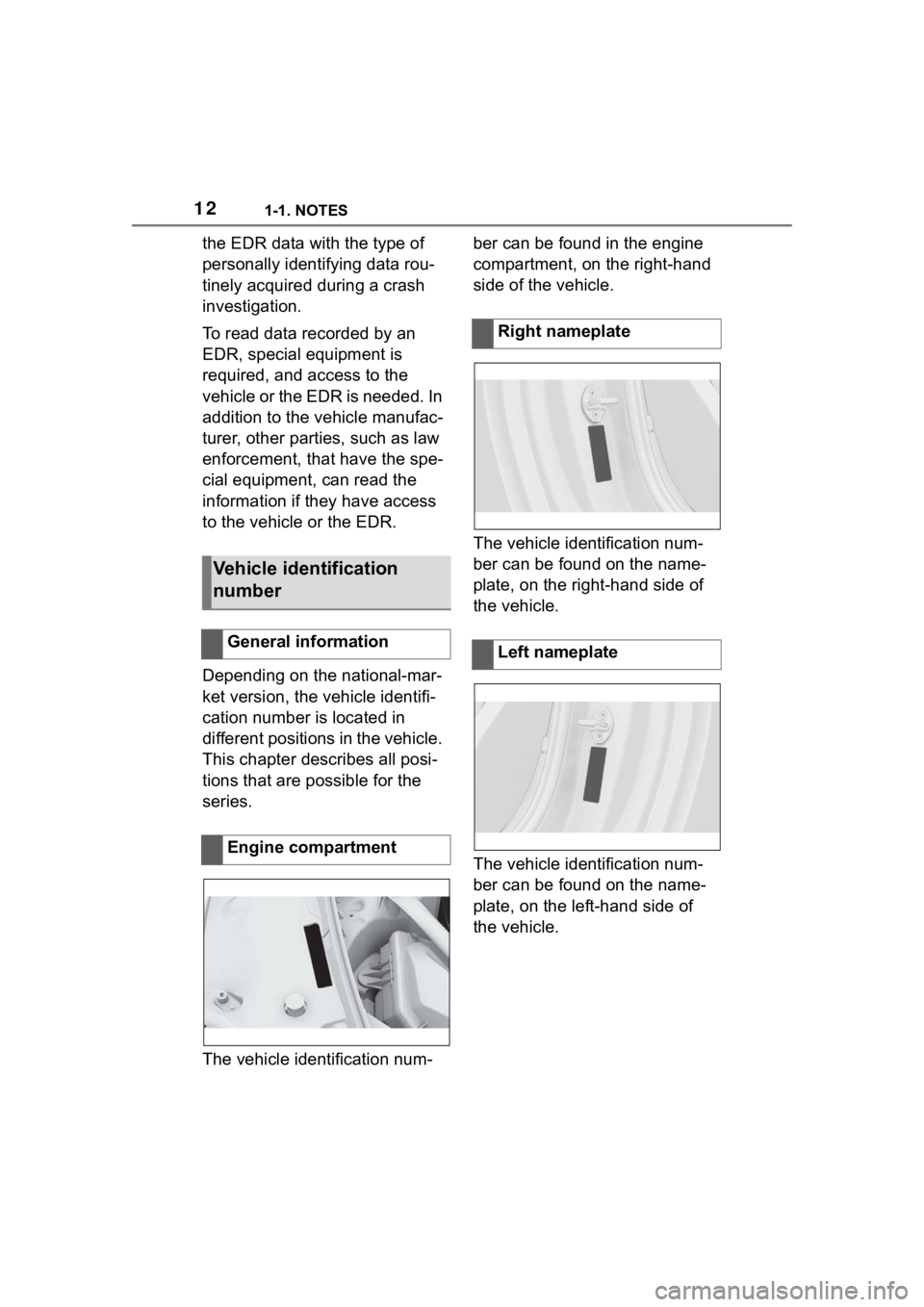
121-1. NOTES
the EDR data with the type of
personally identifying data rou-
tinely acquired during a crash
investigation.
To read data recorded by an
EDR, special equipment is
required, and access to the
vehicle or the EDR is needed. In
addition to the vehicle manufac-
turer, other parties, such as law
enforcement, that have the spe-
cial equipment, can read the
information if they have access
to the vehicle or the EDR.
Depending on the national-mar-
ket version, the vehicle identifi-
cation number is located in
different positions in the vehicle.
This chapter describes all posi-
tions that are possible for the
series.
The vehicle identification num-ber can be found in the engine
compartment, on the right-hand
side of the vehicle.
The vehicle identification num-
ber can be found on the name-
plate, on the right-hand side of
the vehicle.
The vehicle identification num-
ber can be found on the name-
plate, on the left-hand side of
the vehicle.
Vehicle identification
number
General information
Engine compartment
Right nameplate
Left nameplate
Page 13 of 372
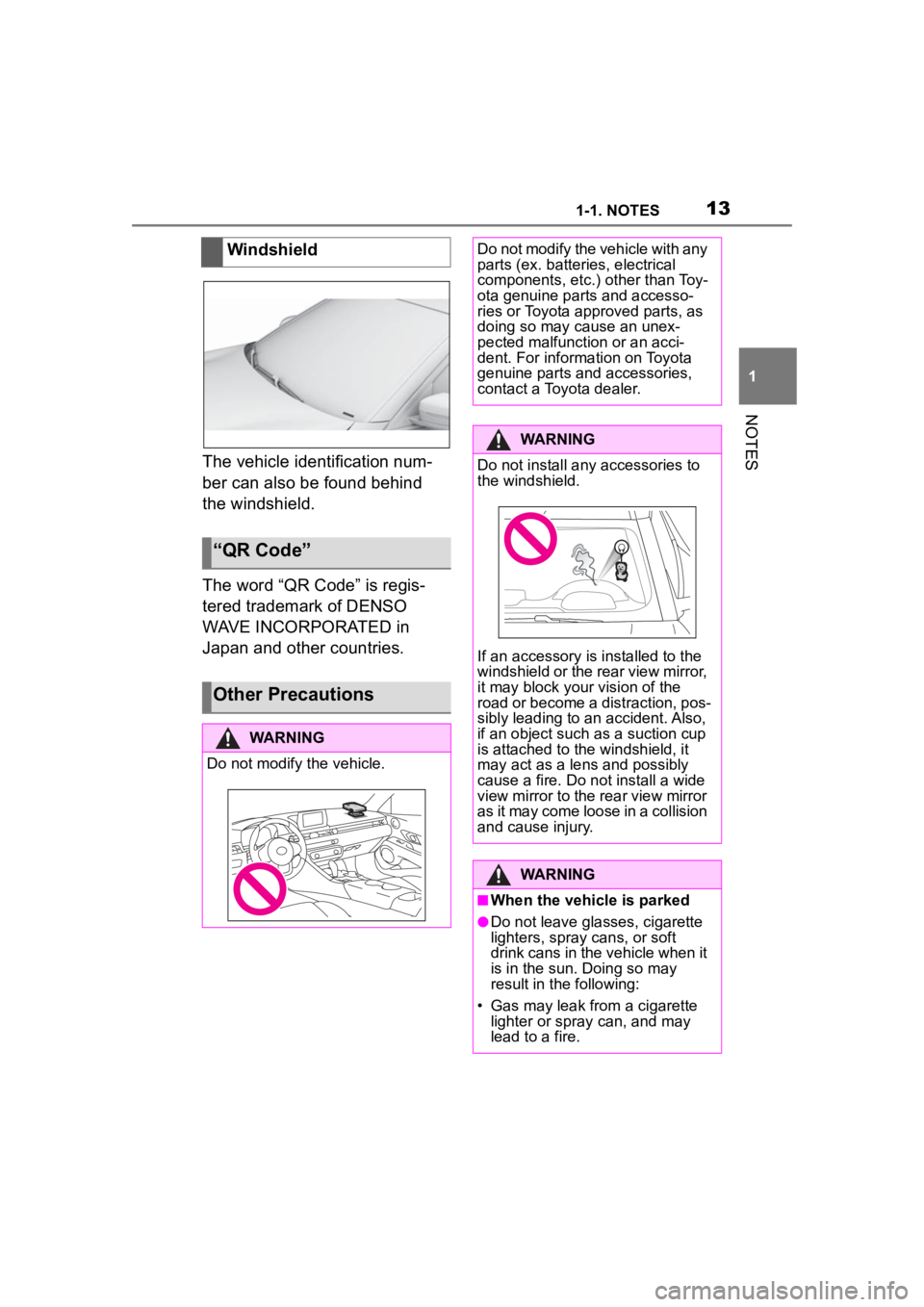
131-1. NOTES
1
NOTES
The vehicle identification num-
ber can also be found behind
the windshield.
The word “QR Code” is regis-
tered trademark of DENSO
WAVE INCORPORATED in
Japan and other countries.Windshield
“QR Code”
Other Precautions
WARNING
Do not modify the vehicle.
Do not modify the vehicle with any
parts (ex. batteries, electrical
components, etc.) other than Toy-
ota genuine parts and accesso-
ries or Toyota approved parts, as
doing so may cause an unex-
pected malfunction or an acci-
dent. For information on Toyota
genuine parts and accessories,
contact a Toyota dealer.
WARNING
Do not install any accessories to
the windshield.
If an accessory is
installed to the
windshield or the rear view mirror,
it may block your vision of the
road or become a distraction, pos-
sibly leading to an accident. Also,
if an object such as a suction cup
is attached to the windshield, it
may act as a lens and possibly
cause a fire. Do not install a wide
view mirror to the rear view mirror
as it may come loos e in a collision
and cause injury.
WARNING
■When the vehicle is parked
●Do not leave glasses, cigarette
lighters, spray cans, or soft
drink cans in the vehicle when it
is in the sun. Doing so may
result in the following:
• Gas may leak from a cigarette lighter or spray can, and may
lead to a fire.
Page 14 of 372
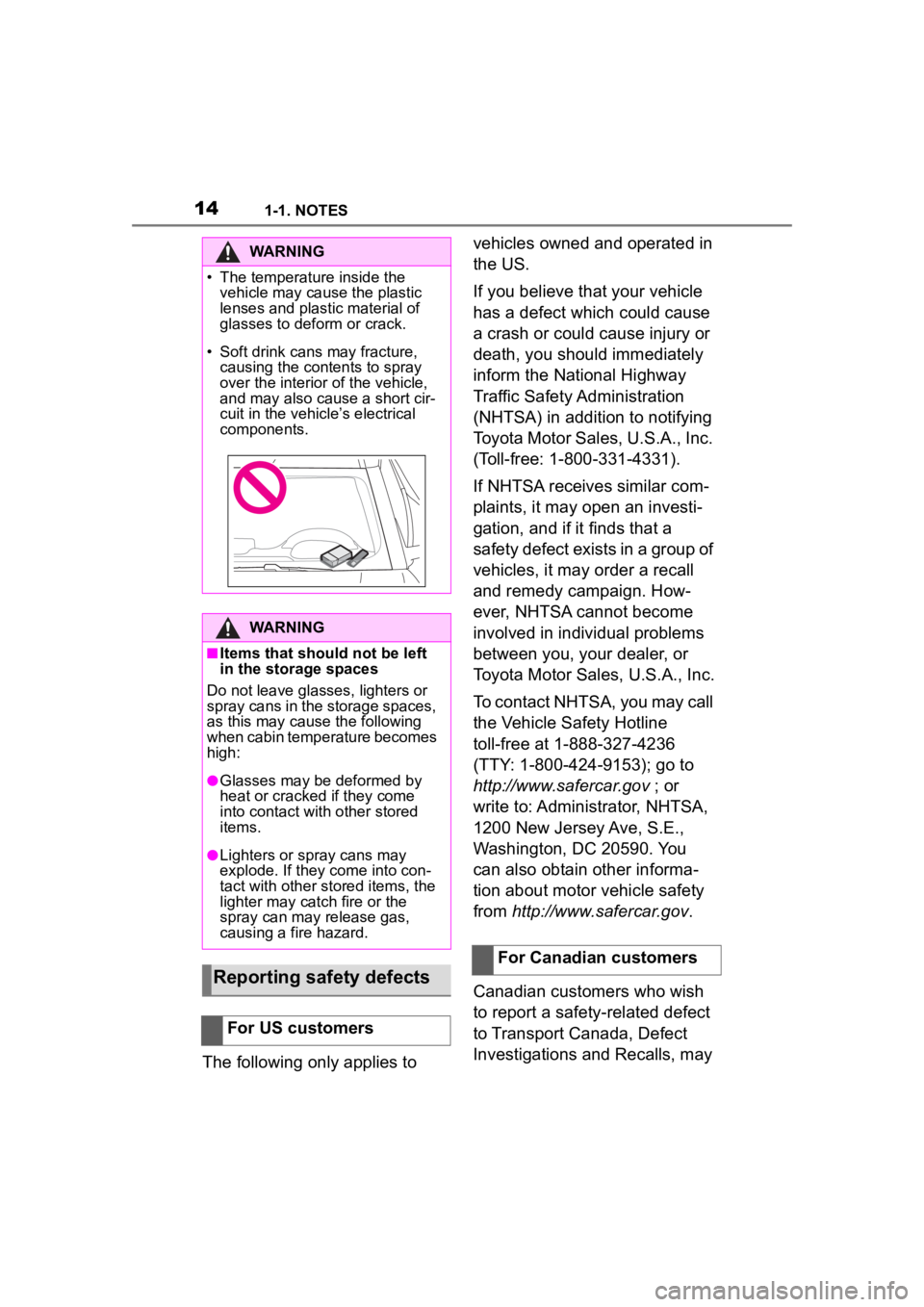
141-1. NOTES
The following only applies to vehicles owned and operated in
the US.
If you believe that your vehicle
has a defect which could cause
a crash or could cause injury or
death, you should immediately
inform the National Highway
Traffic Safety Administration
(NHTSA) in addition to notifying
Toyota Motor Sales, U.S.A., Inc.
(Toll-free: 1-800-331-4331).
If NHTSA receives similar com-
plaints, it may open an investi-
gation, and if it finds that a
safety defect exists in a group of
vehicles, it may order a recall
and remedy campaign. How-
ever, NHTSA cannot become
involved in individual problems
between you, your dealer, or
Toyota Motor Sales, U.S.A., Inc.
To contact NHTSA, you may call
the Vehicle Safety Hotline
toll-free at 1-888-327-4236
(TTY: 1-800-424-9153); go to
http://www.safercar.gov
; or
write to: Administrator, NHTSA,
1200 New Jersey Ave, S.E.,
Washington, DC 20590. You
can also obtain other informa-
tion about motor vehicle safety
from http://www.safercar.gov .
Canadian customers who wish
to report a safety-related defect
to Transport Canada, Defect
Investigations and Recalls, may
WARNING
�
Page 15 of 372

151-1. NOTES
1
NOTES
call the toll-free customer sup-
port 1-800-333-0510. You can
also obtain other information
about motor vehicle safety from
http://www.tc.gc.ca/roadsafety.
Page 16 of 372

161-1. NOTES
Page 17 of 372
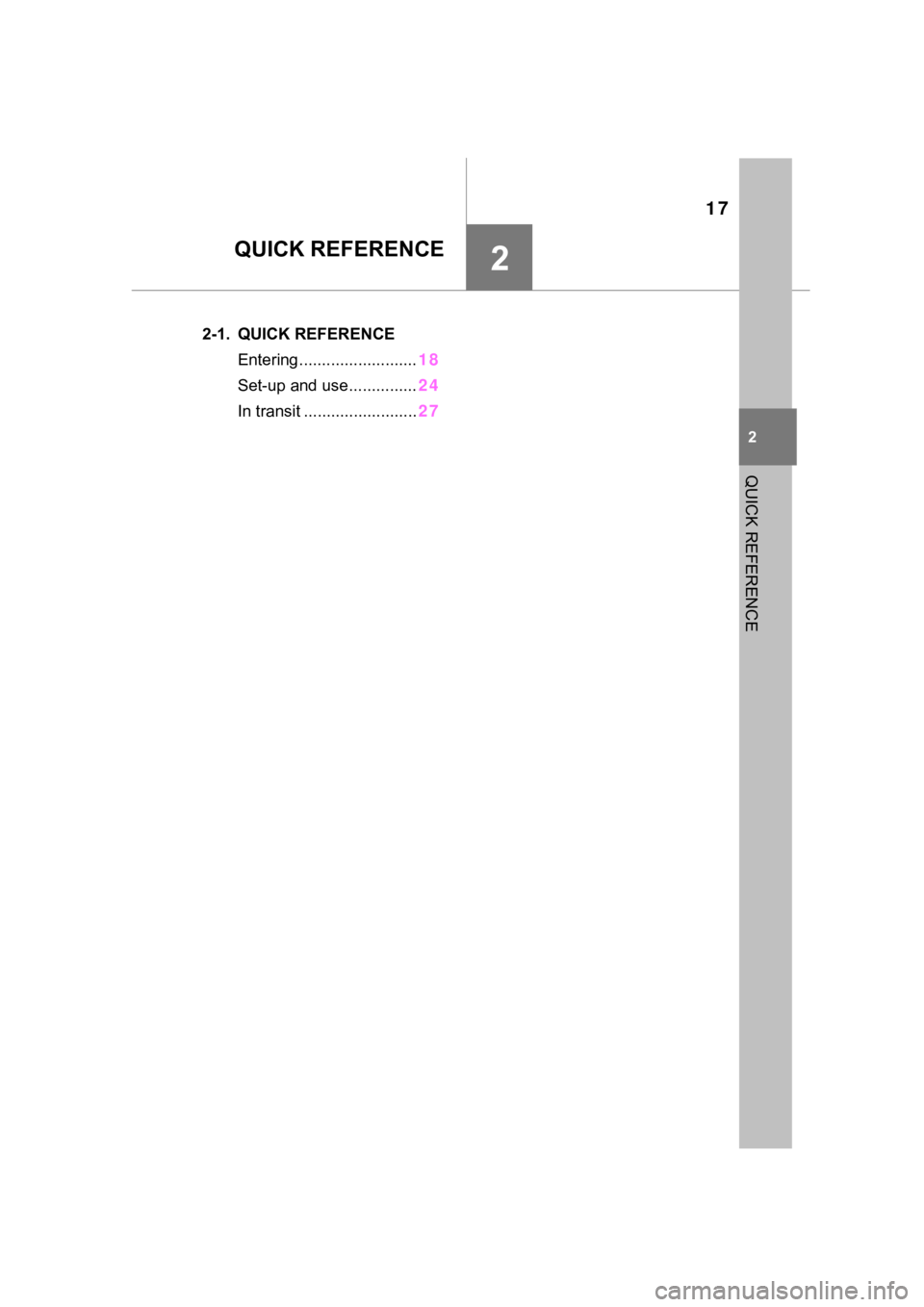
17
2
2
QUICK REFERENCE
QUICK REFERENCE
.2-1. QUICK REFERENCEEntering.......................... 18
Set-up and use ...............24
In transit ......................... 27
Page 18 of 372
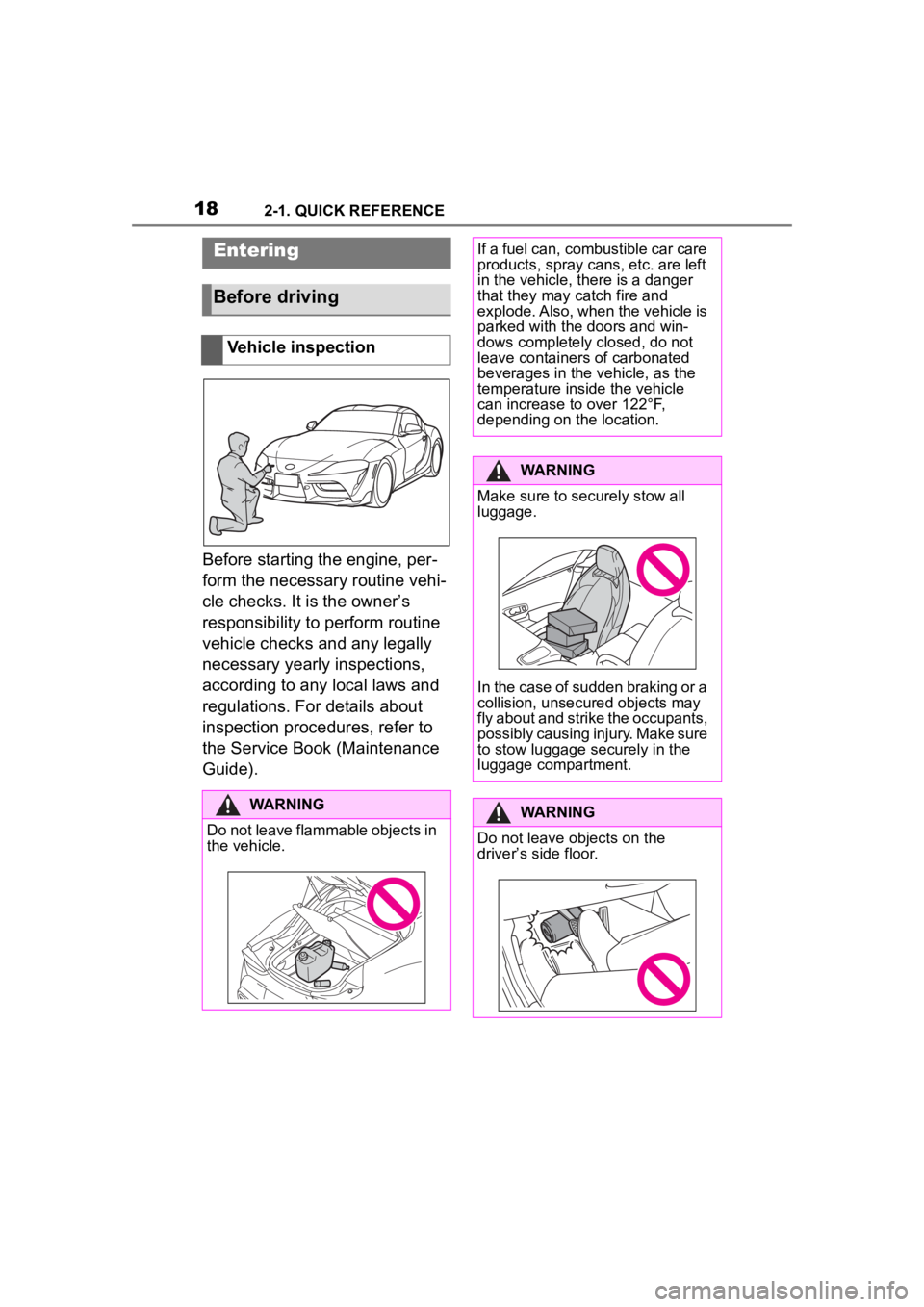
182-1. QUICK REFERENCE
2-1.QUICK REFERENCE
Before starting the engine, per-
form the necessary routine vehi-
cle checks. It is the owner’s
responsibility to perform routine
vehicle checks and any legally
necessary yearly inspections,
according to any local laws and
regulations. For details about
inspection procedures, refer to
the Service Book (Maintenance
Guide).
Entering
Before driving
Vehicle inspection
WARNING
Do not leave flammable objects in
the vehicle.
If a fuel can, combustible car care
products, spray cans, etc. are left
in the vehicle, there is a danger
that they may catch fire and
explode. Also, when the vehicle is
parked with the doors and win-
dows completely closed, do not
leave containers of carbonated
beverages in the vehicle, as the
temperature inside the vehicle
can increase to over 122°F,
depending on the location.
WARNING
Make sure to securely stow all
luggage.
In the case of sudden braking or a
collision, unsecured objects may
fly about and strike the occupants,
possibly causing injury. Make sure
to stow luggage securely in the
luggage compartment.
WARNING
Do not leave objects on the
driver�
Page 19 of 372
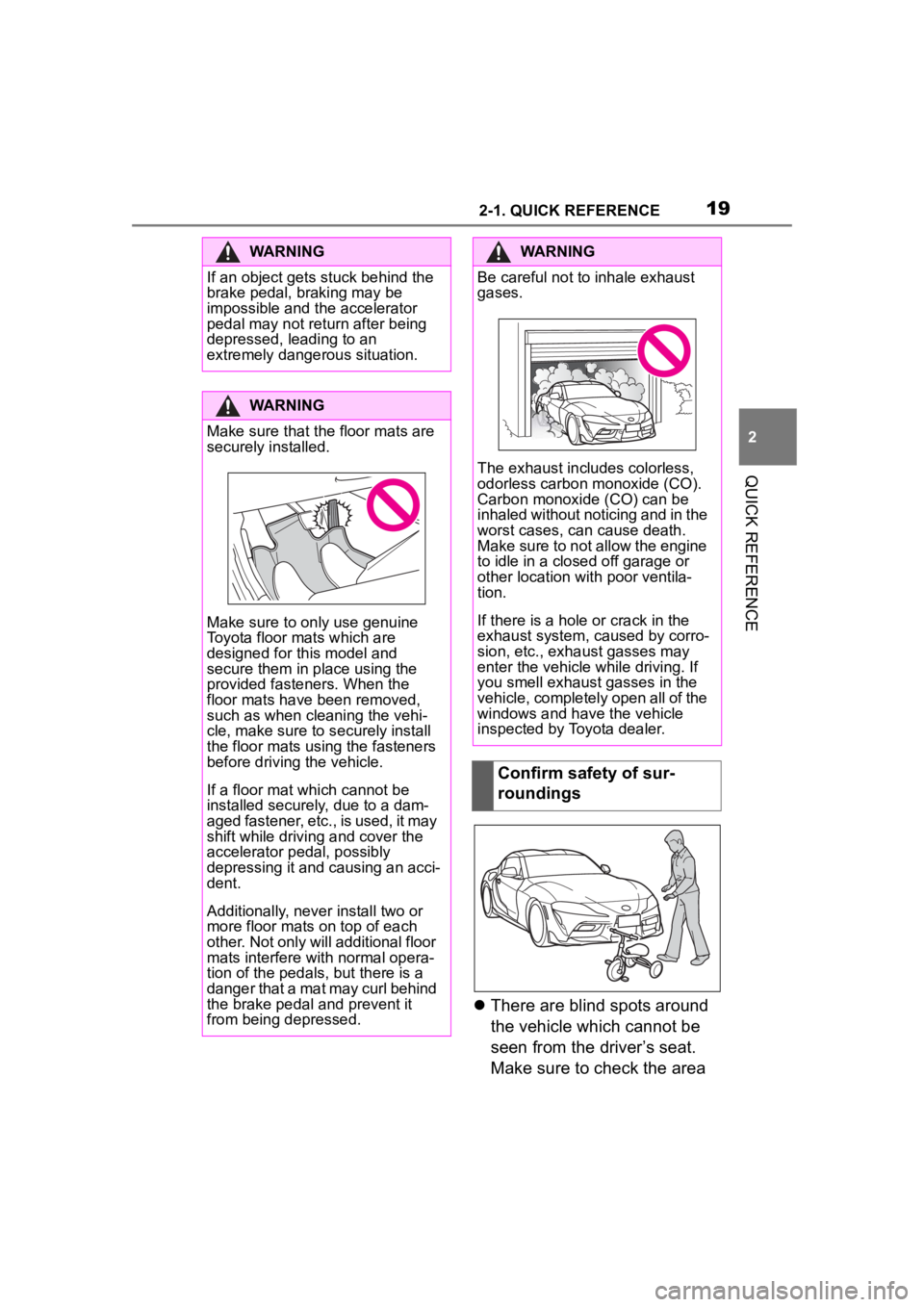
192-1. QUICK REFERENCE
2
QUICK REFERENCE
There are blind spots around
the vehicle which cannot be
seen from the driver’s seat.
Make sure to check the area
WARNING
If an object gets s tuck behind the
brake pedal, braking may be
impossible and the accelerator
pedal may not return after being
depressed, leading to an
extremely dangerous situation.
WARNING
Make sure that the floor mats are
securely installed.
Make sure to only use genuine
Toyota floor mats which are
designed for th is model and
secure them in place using the
provided fasteners. When the
floor mats have been removed,
such as when cleaning the vehi-
cle, make sure to s ecurely install
the floor mats using the fasteners
before driving the vehicle.
If a floor mat which cannot be
installed securely , due to a dam-
aged fastener, etc., is used, it may
shift while drivi ng and cover the
accelerator pedal, possibly
depressing it and causing an acci-
dent.
Additionally, never install two or
more floor mats on top of each
other. Not only will additional floor
mats interfere with normal opera-
tion of the pedals , but there is a
danger that a mat may curl behind
the brake pedal and prevent it
from being depressed.
WARNING
Be careful not to inhale exhaust
gases.
The exhaust includes colorless,
odorless carbon monoxide (CO).
Carbon monoxide (CO) can be
inhaled without noticing and in the
worst cases, can cause death.
Make sure to not allow the engine
to idle in a closed off garage or
other location with poor ventila-
tion.
If there is a hole or crack in the
exhaust system, caused by corro-
sion, etc., exha ust gasses may
enter the vehicle while driving. If
you smell exhaust gasses in the
vehicle, completely open all of the
windows and have the vehicle
inspected by Toyota dealer.
Confirm safety of sur-
roundings
Page 20 of 372
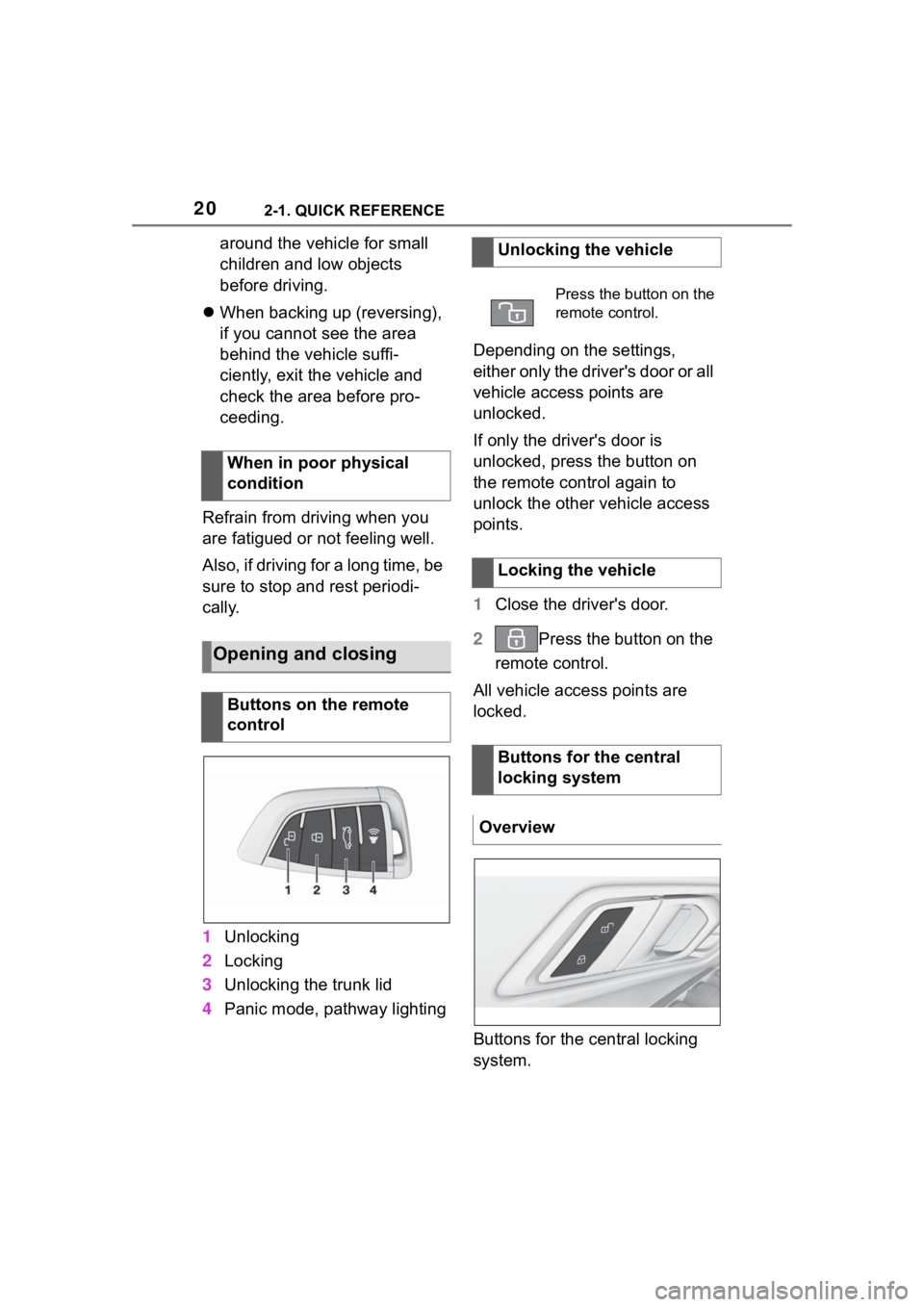
202-1. QUICK REFERENCE
around the vehicle for small
children and low objects
before driving.
When backing up (reversing),
if you cannot see the area
behind the vehicle suffi-
ciently, exit the vehicle and
check the area before pro-
ceeding.
Refrain from driving when you
are fatigued or not feeling well.
Also, if driving for a long time, be
sure to stop and rest periodi-
cally.
1 Unlocking
2 Locking
3 Unlocking the trunk lid
4 Panic mode, pathway lighting Depending on the settings,
either only the driver's door or all
vehicle access points are
unlocked.
If only the driver's door is
unlocked, press the button on
the remote control again to
unlock the other vehicle access
points.
1
Close the driver's door.
2 Press the button on the
remote control.
All vehicle access points are
locked.
Buttons for the central locking
system.
When in poor physical
condition
Opening and closing
Buttons on the remote
control
Unlocking the vehicle
Press the button on the
remote control.
Locking the vehicle
Buttons for the central
locking system
Overview